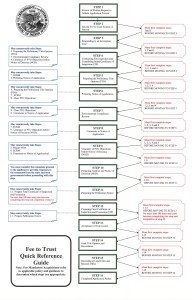It is crucial to have proactive representation with an in-depth knowledge and background involving real estate, title, surveys and federal standards process/requirements during Fee-to-Trust (FTT) conversions. That expertise, in synchronicity with due diligence and persistence are critical for land into trust (FTT) completion. The competence of Native Nations Land Service in Tribal land ownership is necessary to Tribes who are earnest about asserting Tribal jurisdictional authority and their right to self-governance.
There is a gross misconception in Indian country that completing a two (2) page application is the entire “process” to complete trust conversion. If this were the case, then the term “checker-boarded reservation” would be practically non-existent. FTT, is an extensive twelve to eighteen months process that is filled with assessments, complex reports, including public notice and other legal requirements. On top of that, the cost incurred by a Tribe at each federally-required step is so highly variable, and based on circumstance, that some properties cost more to convert to trust than the initial purchase price of the property.
Fee-to Trust conversion is not a simple process. Understand that the DOI has discretionary authority over land into trust requests. Until a property is actually “in trust“, the BIA and its programs have absolutely no (trust) responsibility and are federally-prohibited from providing FTT processing services to Tribes. The Native Nations Land Service has the expertise and experience to help Tribes complete FTT as quickly and cost-effectively as possible.
A quick reference guide to the federally mandated process, showing what a complete application package should consist of is outlined visually below.
The standard requirement for BIA review, before submitting any “application for trust acquisition of fee land“–along with all reports and materials that consist of a complete application package—the Tribe or landowner must the take time to compile all of the required reports to meet federal standards.
The Department of Interior must comply with all federal laws, including, but not limited to:
- National Environmental Policy Act (NEPA)
- 602 Departmental Manual 2 (602 DM2)-Hazardous Substances
- National Historical Preservation Act (NHPA)
- U.S. Department of Justice Title Standards.
It is imperative that the complete application package is prepared fully, with special attention paid to the criteria required for the Secretary of the Interior to authorize a request as identified in 25 CFR § 151.10.
When the complete application package is submitted to the BIA, the Tribe or landowner should have a copy made that is dated, stamped and initialed by the Realty staff. The Realty staff may review the application for its completeness, and then submit it to the Superintendent for on-reservation trust acquisitions or forward on to Region Office for off-reservation trust acquisitions. At this point, applicants should request a copy of the recommendation and make sure everything in the application is still accurate.
Upon receipt of the complete application package, the representative working with the Superintendent at the Agency level would request legal notice to the state and local governments who have regulatory jurisdiction over the land to be acquired. The general public and surrounding landowners will also have a separate thirty (30) day comment period. These government entities and the general public have three (3) separate thirty (30) day windows to provide written comments as to the acquisition’s potential impacts on regulatory jurisdiction, real property taxes and special assessments, or other relevant concerns. The applicant is provided with a copy of these written comments and is given a “reasonable time” in which to reply and/or request that the Secretary issue a decision.
If everything goes smoothly, the deed conveyance will move forward for recording. However, if the State protests, or the local governments protests, the application can go first to the Interior Board of Indian Appeals (IBIA) and ultimately end up in federal court. The IBIA is averaging 4-6 years for hearings.
It is important to note that once the initial completed application package has been submitted, applicants need to stay on top of the application’s movement and status by making regular phone calls to the Realty office to check in.
It is not uncommon for local and county governments to challenge fee-to-trust transfers, because it could result in loss of tax revenue, planned assessments and jurisdiction. In most cases, Indian nations should be prepared to educate neighboring communities about the importance and benefits of restoring Indian lands to Indian control and trust status. Some of the benefits include:
- economic development and jobs
- new community amenities
- natural or cultural resource protection.
Individuals seeking to have fee lands transferred to trust status can also encounter resistance either from the Tribe, the BIA or other entities. In general, the BIA gives priority to Tribal over individual fee-to-trust transfers. Attitudes toward individual fee-to-trust transfers can vary dramatically from one region or agency to the next, and, these attitudes can influence the process itself. Landowners should fully understand their rights and responsibilities regarding fee-to-trust transfers and be prepared to advocate for their position every step of the way.
Generally, the fee-to-trust process takes anywhere from 12 to 18 months. Occasionally a transfer will take less time, but this is rare, and is usually due to extreme persistence on the part of the Tribe or individual landowner who has submitted the request. A request may also take much longer if the case is complicated by any number of factors such as zoning, economic and/or environmental impact, remediation requirements, County or local municipality challenges.
